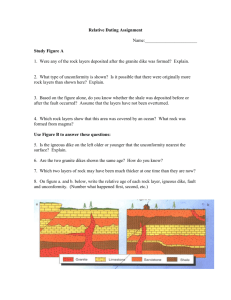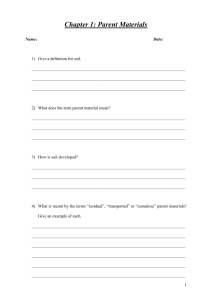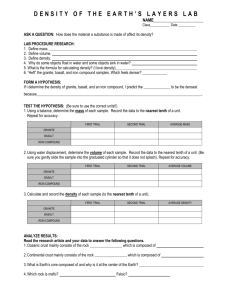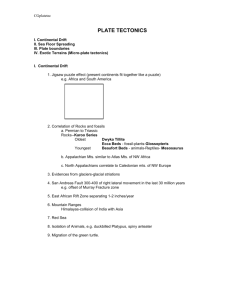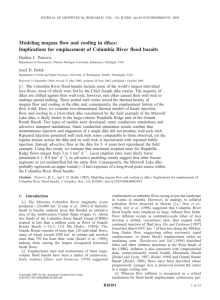Answers in BOLD BLUE 1 Geology 100
advertisement
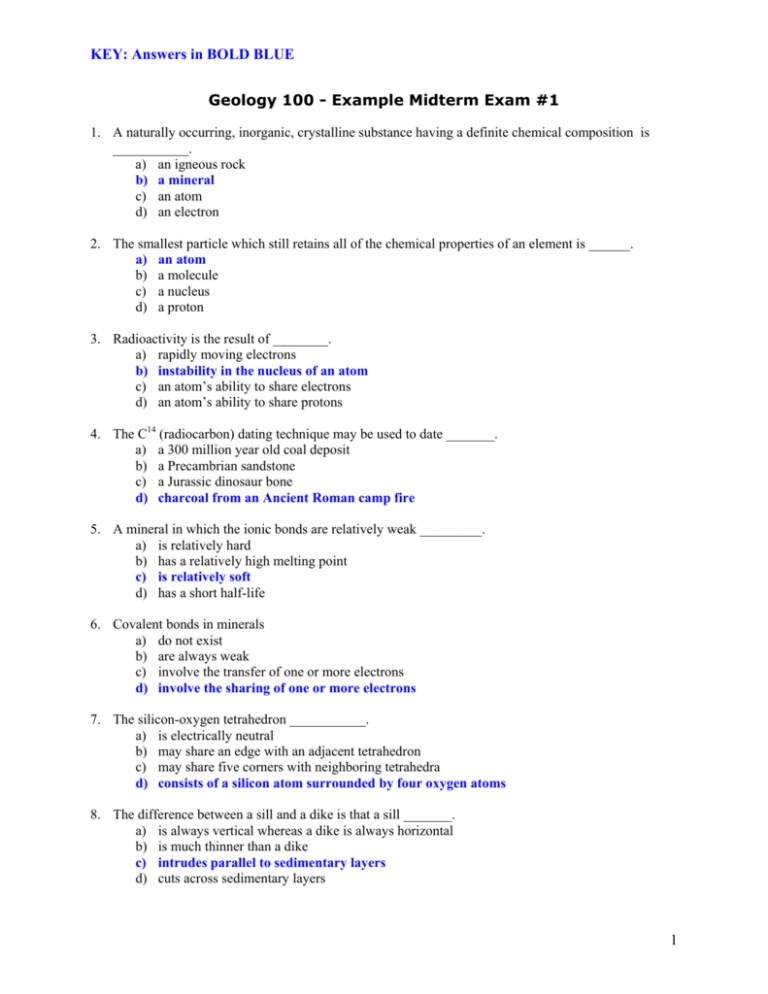
KEY: Answers in BOLD BLUE Geology 100 - Example Midterm Exam #1 1. A naturally occurring, inorganic, crystalline substance having a definite chemical composition is ___________. a) an igneous rock b) a mineral c) an atom d) an electron 2. The smallest particle which still retains all of the chemical properties of an element is ______. a) an atom b) a molecule c) a nucleus d) a proton 3. Radioactivity is the result of ________. a) rapidly moving electrons b) instability in the nucleus of an atom c) an atom’s ability to share electrons d) an atom’s ability to share protons 4. The C14 (radiocarbon) dating technique may be used to date _______. a) a 300 million year old coal deposit b) a Precambrian sandstone c) a Jurassic dinosaur bone d) charcoal from an Ancient Roman camp fire 5. A mineral in which the ionic bonds are relatively weak _________. a) is relatively hard b) has a relatively high melting point c) is relatively soft d) has a short half-life 6. Covalent bonds in minerals a) do not exist b) are always weak c) involve the transfer of one or more electrons d) involve the sharing of one or more electrons 7. The silicon-oxygen tetrahedron ___________. a) is electrically neutral b) may share an edge with an adjacent tetrahedron c) may share five corners with neighboring tetrahedra d) consists of a silicon atom surrounded by four oxygen atoms 8. The difference between a sill and a dike is that a sill _______. a) is always vertical whereas a dike is always horizontal b) is much thinner than a dike c) intrudes parallel to sedimentary layers d) cuts across sedimentary layers 1 KEY: Answers in BOLD BLUE 9. The common intrusive igneous rock types in order from low silica content to high silica content are ________. a) peridotite, granite, diorite b) peridotite, diorite, gabbro c) basalt, rhyolite, andesite d) gabbro, diorite, granite 10. The order in which minerals crystallize from a cooling magma is: a) amphibole, pyroxene, biotite, olivine, quartz, alkali feldspar b) quartz, alkali feldspar, biotite, amphibole, pyroxene, olivine c) pyroxene, amphibole, olivine, biotite, alkali feldspar, quartz d) olivine, pyroxene, amphibole, biotite, alkali feldspar, quartz 11. The differences in grain size between extrusive and intrusive igneous rocks is primarily due to_________. a) different rates of cooling and crystallization b) different mineral compositions c) different amounts of volatiles in the magmas d) different magma compositions 12. Kilauea in Hawaii is an example of a _________. a) composite volcano b) spatter cone c) shield volcano d) cinder cone 13. The framework silicate structure is exemplified by the mineral _________. a) Quartz b) Feldspar c) Olivine d) both a) and b) 14. The breaking of a mineral, when struck, along preferred directions is called ________. a) luster b) crystal form c) cleavage d) hardness 15. The most abundant group of minerals in the earth’s crust is the _________. a) feldspar group b) pyroxene group c) amphibole group d) mica group 16. A volcano that is constructed of alternating layers of pyroclastics and solidified lava flows is called ________. a) a shield volcano b) a composite volcano c) a maar-type volcano d) a cinder cone 2 KEY: Answers in BOLD BLUE 17. A pahoehoe lava __________. a) is generally basaltic in composition b) has a ropy appearance c) forms close to the volcanic vent d) all of the above 18. An angular unconformity implies that the following geologic event(s) occurred: a) tilting b) erosion c) deposition d) a) and c) only e) a), b), and c) 19. The principle of superposition applies to ___________. a) layers of sedimentary rock b) metamorphic rocks only c) dikes d) lithospheric plates 20. Rhyolitic (felsic) magmas _________. a) form large shield volcanoes b) have a low viscosity c) always erupt on the ocean floor d) none of the above 21. Which of the following pairs of rock types have formed from magma having the same general composition? a) granite and andesite b) diorite and rhyolite c) gabbro and basalt d) peridotite and andesite 22. Obsidian _________. a) is composed of the minerals quartz and feldspar b) is basaltic (mafic) in composition c) has a glassy texture d) all of the above 23. The Cenozoic Era is characterized primarily by what type of life? a) Reptiles b) Mammals c) only soft-shelled fossils d) Invertebrate marine life 24. The process by which a very hot magma may melt some of the surrounding country rock and incorporate the newly molten country rock material into the magma is called __________. a) fractional crystallization b) differentiation c) assimilation d) orogenesis 3 KEY: Answers in BOLD BLUE 25. All of the following are characteristic products from a pyroclastic eruption except __________. a) ignimbrites b) volcanic ash c) pumice d) Aa lavas 26. An important way to transport molten basalt flows over long distances is ________. a) through lava tubes b) as pillow basalts c) by draining a lava lake d) by FedEx 27. The Earth's magnetic field a. causes orientation of magnetic minerals in any rock millions of years after the rock forms b. apparently has never changed direction c. is probably caused by convection in the mantle d. has its poles in exactly the same location as the geographic poles e. causes orientation of magnetic minerals during crystallization of a magma 28. In addition to continental North America, the North American plate includes the a. eastern half of the Pacific Ocean crust b. western half of the North Atlantic Ocean crust c. Cocos plate d. Nazca plate e. East Pacific rise 29. The Andes Mountains are believed to be the result of a. a part of the oceanic ridge system that slid under the continent b. the drift of a part of the Himalayas across the Pacific c. an enormous unconformity d. the convergence of large lithospheric plates e. lava welling up from the Peru-Chile trench 30. The zone of plastic rock beneath the lithosphere is called the a. stratosphere b. thermosphere c. magnetosphere d. mantle e. asthenosphere 31. The oldest oceanic lithosphere is about a. 2.0 billion years old b. 200 million years old c. 20 million years old d. 2.0 million years old e. 200,000 years old 4 KEY: Answers in BOLD BLUE 32. The deepest earthquakes are found at what depths a. 300 km b. 700 km c. 3000 km d. the inner core e. the boundary between mantle and core 33. Present-day examples of spreading centers are a. the Himalayan chain and the Pacific Ocean Ridge b. the Philippines and the Atlantic Ocean Ridge c. the Aleutian chain and the Atlantic Ocean Ridge d. the Red Sea and the Atlantic Ocean Ridge e. the Persian Gulf and the Pacific Ocean Ridge 34. Present-day example(s) of convergent plate boundaries are a. the Himalayas b. the Alps c. the Philippines d. Japan e. All of the above 35. The Earth’s internal energy is primarily responsible for all of the following except: a. earthquakes b. lithospheric plate movements c. erosion d. volcanism 36. Most of what we know about the Earth’s interior has been learned from analysis of ___________. a. volcanic rocks b. deep ocean sediment cores c. seismic waves d. earthquake distributions around the globe 37. Geomagnetic reversals ________________________. a. provide strong evidence for sea-floor spreading b. confirmed the existence of subduction zones c. cause the movement of lithospheric plates d. provide strong evidence that polar wandering may have occurred 38. The earth's primary layers as defined by their chemical composition are a. crust, lithosphere, mantle, asthenosphere b. lithosphere, asthenosphere, mesosphere c. mantle, asthenosphere, core d. crust, mantle, core 39. Which of the following is not a line of evidence used to support the theory of plate tectonics? a. the distribution of certain fossil types on different continents b. rock magnetism and wander of the paleomagnetic north pole c. the existence of the rock cycle d. the topography and age of the seafloor 5 KEY: Answers in BOLD BLUE 40. Plate Tectonics refers to the hypothesis that a. heat moves outward from the earth's core over geologic time b. continents drift across the earth's mantle, plowing through seafloor like icebergs c. earthquakes must occur along the narrow boundaries that separate most plates d. the earth's surface is composed of a mosaic of independently moving, rigid plates e. b&c 41. The three types of tectonic plate boundaries are a. transcurrent, convergent, divergent b. divergent, convergent, rupture c. subduction, convergent, strike-slip d. uplift, subduction, lateral escape e. strike-slip, transform, divergent 42. Earthquakes along the mid-ocean ridge system are most likely to record which kinds of motion? a. transcurrent or divergent b. divergent or convergent c. transcurrent or convergent 43. Which of the following is the longest mountain chain? a. Mid-Atlantic Ridge b. Himalayas c. Alps d. Rocky Mountains 44. Continental crust is thicker and denser than oceanic crust. a. True b. False 45. Rocks of granitic composition commonly erupt from a mid-ocean ridge. a. True b. False 46. Most earthquakes are concentrated in narrow geographic belts a. True b. False 6 KEY: Answers in BOLD BLUE Use the diagram below, which illustrates the cross-cutting relations of a series of geologic units, to work out the relative ages of the section for Questions # 47-52. 47. The Madison Granite is __________________. a) older than the Bascom Fm b) younger than the Bascom Fm. c) younger than the Weeks Sandstone d) this age relationship is impossible to determine 48. The principle that tells us that the Basalt Dike is older than the Basalt Sill is the principle of _______. a) superposition b) lateral continuity c) cross-cutting relations d) inclusions 49. The deformation of the Bascom Fm. is ________. a) older than the intrusion of the Madison Granite b) older than the Basalt Dike c) younger than the Demets Shale d) both a) and b) are correct 7 KEY: Answers in BOLD BLUE 50. The Mendota Dolomite is older than the _________, and younger than the ___________. a) Dayton Limestone, Demets Shale b) Johnson Till, Weeks Sandstone c) Monona Shale, Basalt Dike d) Wingra Sandstone, Basalt Dike 51. The principle that tells us that the Wingra Sandstone is older than the Demets Shale is the principle of: a) inclusions b) faunal succession c) superposition d) lateral continuity 52. The age relationship between the Johnson Till and the Basalt Dike ___________. a) cannot be determined b) can be established from the principle of original horizontality c) can be established from the principle of correlation d) can be established from the principle of cross-cutting relations 53. Surface C is an example of _____________. a) an angular unconformity b) a disconformity c) a nonconformity d) none of the above 54. The surface between the Mendota Dolomite and the Wingra Sandstone is __________. a) erosional b) a disconformity c) an angular unconformity d) both a) and c) 55. The Fault is __________________. a) older than every rock unit shown on the diagram b) younger than Weeks Sandstone c) younger than the Madison Granite d) none of the above 56. The surface between the Madison Granite and the Weeks Sandstone is __________. a) an angular unconformity b) a disconformity c) a nonconformity d) an intrusive contact 8
